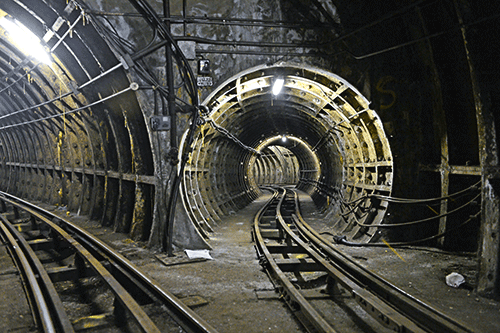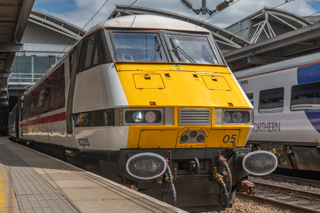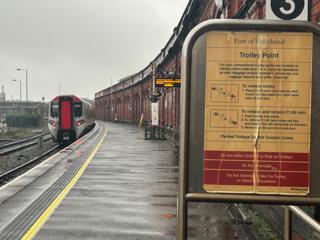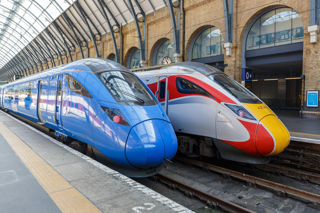Everyone loves a good secret, a piece of history with colourful stories to tell. And it doesn’t get much better than a secret on your doorstep, waiting to be uncovered.
Many visitors to the capital - and even many Londoners - have no idea that such a place lurks underground in Clerkenwell, sleeping under the Victoria Line. But this special place will not lie dormant for much longer.
It was announced back in 2014 (RAIL 734) that Mail Rail (opened in 1927 and formerly known as the Post Office Underground Railway) was to open to the public for tours as part of a new postal museum at Mount Pleasant. The 6½-mile (10.5km) line had transported letters across London between sorting offices, before being mothballed in 2003 when it no longer became viable.
The British Postal Museum and Archive needed to raise the not inconsiderable sum of £22 million in order to make opening it a reality. The original plan was to open the main Postal Museum this year and then open the Mail Rail portion in 2019. But after raising a total of £26m, the whole museum will now open together - two years early - in 2017.
Adrian Steel, director of the newly named Postal Museum, opened a ‘breaking ground’ event on February 4 to mark the transformation of Mail Rail from a sleeping time capsule into a site that will help to tell the history of communication.
The name Postal Museum conjures up images of stamps, post boxes and red vans, but this new experience is about much more than that. As Steel said at the February 4 event: “This is about five centuries of social history from an institution that changed the world.
“The stories within will surprise and enthral, spark curiosity, push the boundaries. We aim to become a high-class, immersive and innovative experience, which everyone will want to visit. Here at Mail Rail, the stories of endeavour and ingenuity, which saw the mail move across distances long and short, in all sorts of weathers and by a workforce rich in diversity, pride and spirit, will take centre stage.
“The tunnels will resound with an audio-visual symphony for the passengers of our two new Mail Rail trains, which will take our visitors on a journey through time under London of postal past.”
It has taken years of fundraising to get this far (starting long before 2014). Royal Mail, Post Office and the Heritage Lottery Fund contributed the lion’s share of the funds, but a host of trusts, foundations and individuals also donated to the cause.
Fundraising doesn’t stop there, though - the more the museum can raise, the better the experience for visitors. One of the ways this is already continuing is through a ‘Sponsor a sleeper’ initiative. This allows individuals to donate £250 to have their name engraved on a plaque affixed to one of the new sleepers required on the railway. The price includes a trip into the tunnels to see your sleeper ‘literally supporting the railway’.
And there are still challenges to overcome, even with the funding having been raised. The entrance to Mail Rail involves crossing the road from where the main Postal Museum building will be. That road forms the boundary between Camden and Islington boroughs, so some negotiation will be required to put a pedestrian crossing between the two. The museum is determined to make the place somewhere for the community, however, and is hoping to engage local residents in the site through an education centre and other initiatives.
The team behind Mail Rail is keen to ensure that construction does not fundamentally change the infrastructure of the site. They want to present an authentic experience and maintain the natural appeal of the location.
Where this becomes more challenging is with the trains, as Mail Rail was never intended to carry passengers through its tunnels. Driverless trains ran on the third rail, carrying letters through the tunnels. One of the reasons the railway closed was because people were sending fewer letters and more parcels, which the railway wasn’t well equipped to handle.
This is also why only one kilometre (0.6 miles) of the tunnels can be used for the passenger ride experience - letters never needed fire escapes en route!
With the line being only 2ft gauge, every inch of space is important. The third rail is being removed as part of the project, to allow the trains to be dropped lower onto the track, providing a more comfortable seating position for passengers.
Steel told RAIL that Severn Lamb in Stratford-upon-Avon (which specialises in scenic railways and miniaturised traction) is building two new passenger trains for the line. They will comprise three carriages each and run on battery power.
Passengers will sit on benches, some facing forward and some back. With such a small gauge, only one adult and one child will fit on each bench, meaning that each train could carry 15-16 adults or 30-32 people in total if half are children.
One train will be green (the colour of the original trains when they entered service) and the other red (the colour when they left service).
Detailed designs for the trains are already under way, so it’s now a case of assessing the practicalities and making tweaks before they go into production. It is expected that the first one will be ready by the summer.
In the meantime, with the ‘breaking ground’ ceremony complete, work can begin apace in preparation for opening in 2017.
Broadcaster Dan Snow broke the first ground at the site (RAIL 794). He has a long-standing interest in Mail Rail and donned a hi-vis to ceremonially begin work on the site by taking a sledgehammer to a redundant wall in the car depot.
“I first came here in 2013 and I was blown away by it. I had no idea that there was a network of tunnels that stretch from Paddington to Whitechapel. Narrow gauge railways that have kept London moving through thick and thin, through wars and economic slumps.
“I’ve been to historic sites and museums from the Shetlands to the Scilly Isles and all around the world, and I don’t think I’ve ever seen anywhere like this. And it was under my feet, in my home city, and I’d never heard of it.
“There are three things that people really like: being underground in cool spaces, trains, and industrial heritage. Stuff that was carved out of the rock by extraordinarily hardworking men and women whose names could be so easily lost were it not for archives. This museum, this attraction, almost uniquely combines all of those things. And it’s in London as well.
“When I came here a few years ago, I thought they were mental trying to raise £26m, and here we are having a ceremony. I’m glad to be wrong!”
- This feature was published in RAIL 795 on March 2 2016
















Manchester Mike - 25/04/2016 13:50
Great to see this engineering heritage being brought back to life, I look forward to riding the Mail Rail trains!